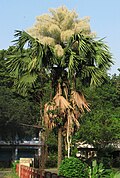| Corypha | |
|---|---|
 | |
| Corypha umbraculifera painting (1913) | |
| Scientific classification | |
| Kingdom: | Plantae |
| Clade: | Tracheophytes |
| Clade: | Angiosperms |
| Clade: | Monocots |
| Clade: | Commelinids |
| Order: | Arecales |
| Family: | Arecaceae |
| Subfamily: | Coryphoideae |
| Tribe: | Corypheae |
| Genus: | Corypha L. |
| Synonyms [1] | |
| |
Corypha or the gebang palm, buri palm or talipot palm is a genus of palms (family Arecaceae), native to India, Malaysia, Indonesia, the Philippines, New Guinea and northeastern Australia (Cape York Peninsula, Queensland). They are fan palms (subfamily Coryphoideae), and the leaves have a long petiole terminating in a rounded fan of numerous leaflets.
Contents
All are large palms with leaves ranging from 2–5 metres in length. They reach heights of 20–40 m and with a trunk diameter of up to 1-2.5 m. All the species are monocarpic and die after flowering. The genus is relatively slow growing and can take many years to form a trunk.
Species include: [2]
| Flower | Name | Common name | Distribution |
|---|---|---|---|
 | Corypha lecomtei Becc. ex Lecomte | Thailand, Vietnam, Laos, Cambodia | |
| Corypha microclada Becc. | Philippines | ||
 | Corypha taliera Roxb. | India: West Bengal, Bangladesh, Myanmar | |
 | Corypha umbraculifera L. | Talipot palm | Sri Lanka, southern India; naturalized in Thailand, Cambodia, Myanmar, Andaman Islands, Mauritius |
 | Corypha utan Lam.(syn. C. elata, C. gebang) | Gebang palm, buri palm or cabbage palm | India: Assam, Andaman Islands, Indochina, Malaysia, Indonesia, Philippines, New Guinea, Australia: Queensland, Northern Territory |



